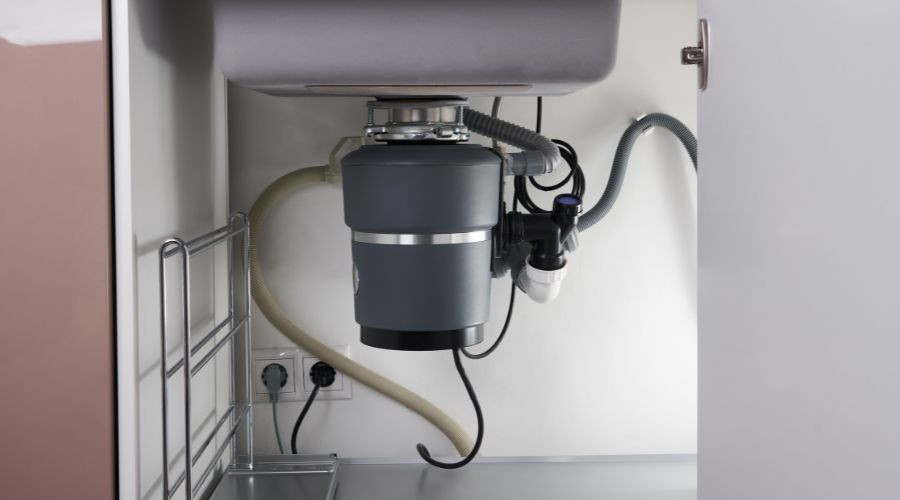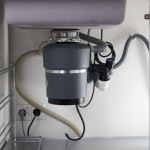Take Better Care of the Garbage Disposal
A garbage disposal is a helpful kitchen appliance that grinds up food waste so it can better travel down the drain and pipes without causing clogs. However, when people don’t use garbage disposals correctly or put the wrong items in them, it can lead to problems like a malfunctioning garbage disposal and a clogged sewer line.
When wanting to avoid these problems, understanding how to use the garbage disposal correctly is essential. This blog post will share some simple yet effective tips that can help protect the garbage disposal and prevent sewer line clogs.
Be Mindful of What Goes in the Garbage Disposal
 A garbage disposal is designed to handle certain food scraps, but many homeowners unknowingly damage their units or cause clogs by disposing of the wrong things in them. Items that should never go down garbage disposals include things like:
A garbage disposal is designed to handle certain food scraps, but many homeowners unknowingly damage their units or cause clogs by disposing of the wrong things in them. Items that should never go down garbage disposals include things like:
- Coffee grounds
- Grease, oils, and fats
- Eggshells
- Fibrous or stringy foods like pumpkin, corn husks, asparagus, and more
- Expandable foods like pasta, rice, bread, and more
- Bones
- Fruit pits
- Potato peels
- Any non-food items or trash
What people can put down the garbage disposal includes ice, the rinds from citrus fruits, small scraps of cooked meats, and fruits and vegetables, besides the exceptions of fibrous vegetables and potato peels. When in doubt, throw it in the garbage.
Run Cold Water and Ice Through the Garbage Disposal
 Running cold water while operating the garbage disposal and for about 30 seconds after turning it off is essential for its optimal performance and longevity. Cold water helps solidify any grease or oils that may have gone down the drain accidentally, allowing them to be solidified and chopped up by the disposal rather than coating the blades and pipes to form clogs. Running cold water after the disposal is turned off also helps ensure all food particles are completely flushed through the system.
Running cold water while operating the garbage disposal and for about 30 seconds after turning it off is essential for its optimal performance and longevity. Cold water helps solidify any grease or oils that may have gone down the drain accidentally, allowing them to be solidified and chopped up by the disposal rather than coating the blades and pipes to form clogs. Running cold water after the disposal is turned off also helps ensure all food particles are completely flushed through the system.
Running ice cubes through the garbage disposal routinely, around once a week, can also be beneficial. As the disposal grinds the ice, the frozen chunks help wash away food particles and buildup that have accumulated on the blades and grinding chamber walls. This helps prevent foul odors that can occur when food is stuck in the garbage disposal. The ice can also help sharpen the disposal's blades.
Don’t Put Too Much Down the Garbage Disposal at Once
Overloading the garbage disposal is another common mistake homeowners can make, which can lead to sewer line clogs and problems with the garbage disposal. While disposals are designed to handle certain food waste, putting a large amount of anything down the disposal, even foods that it can handle, is bad for the disposal and pipes.
People shouldn't overwhelm the disposal with large quantities of food waste at once. To maintain optimal performance, break down larger food scraps into smaller, more manageable pieces before feeding them into the disposal. Additionally, food scraps should be put in the disposal gradually while running cold water, allowing each portion to be fully ground before adding more. This approach helps prevent clogs and problems with the disposal's motor and grinding components, which can help save homeowners money on unclogging sewer lines and garbage disposal repair and replacement in the long run.
About Postma Heating & Cooling
Postma Heating & Cooling is a heating, air conditioning, electrical, and plumbing company serving Chatham-Kent, ON, and the surrounding areas. They offer same-day services, flat-rate pricing, and on-time service. Call them for kitchen plumbing and garbage disposal services in Chatham-Kent, ON.





